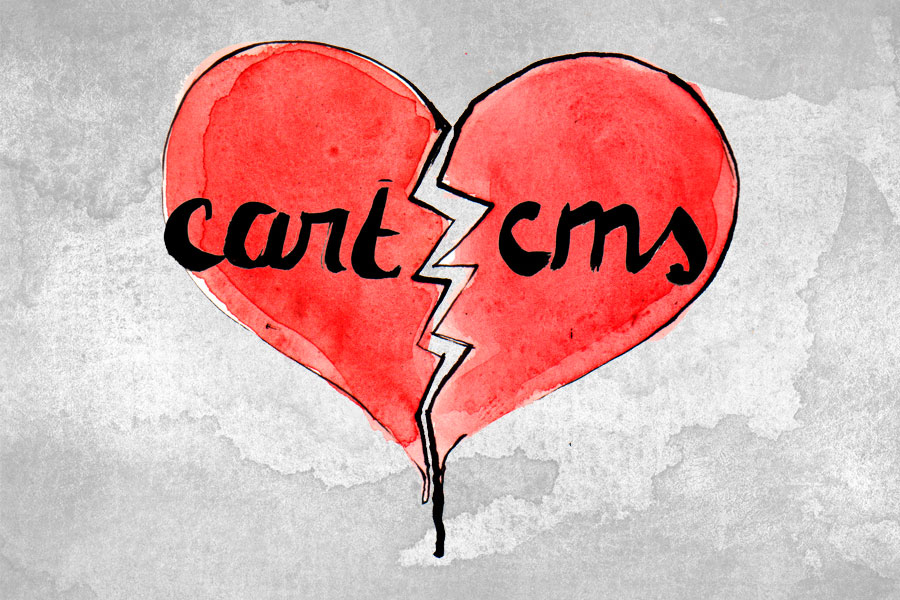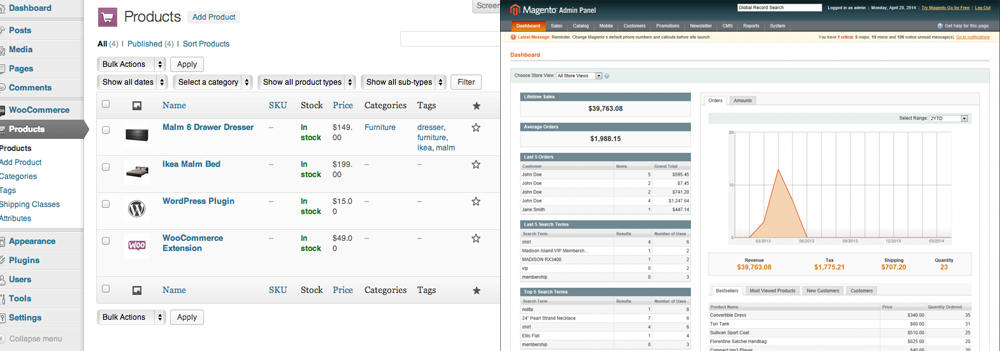Why You Should Separate Your Shopping Cart from Your CMS
November 20, 2017 - Best Practices

Many business owners that want to add ecommerce functionality to their existing website are drawn to plugins. After all, they can be added in a matter of minutes and add functionality without having to move to an entirely new ecommerce platform. The problem is that many existing websites aren’t built for ecommerce – and that can lead to a host of problems. The problems may not arise immediately, but they tend to spiral in size as you grow.
Many existing websites aren’t built for ecommerce - and that can lead to a host of problems. Click To Tweet
We are firm believers in separating your shopping cart from your content management system – or CMS – because they are fundamentally different systems. To understand why, let’s take a look at the evolution of CMS and shopping carts and then look at some of the problems that arise when you combine them using plugins. Finally, we will look at how you can effectively separate the two without the headache of switching platforms.
What is a CMS?
The first websites were simply HTML files on a remote server. If you wanted to maintain a consistent look and feel between them, each file had to be updated using ‘find and replace’ and then re-uploaded to the remote server. Dynamic languages were created to enable developers to reuse code, such as a header, and only update one file. Databases were then added to dynamically populate templates and avoid managing thousands of different files.
Content management systems use dynamic languages and databases to simplify content management. Rather than creating individual files, these applications use databases to populate templates and route visitors to content. Business owners are free to focus on managing their content rather than worrying about technical details. Since then, content management systems have further evolved to become full-fledged marketing platforms with a drag-and-drop design.
WordPress is the most popular CMS in the world with a 59.7% market share and accounts for 28.9% of all websites, according to W3Techs. Joomla (6.7%), Drupal (4.7%), Magento (2.3%), and Blogger (1.9%) round out the top five CMS, while WordPress, Shopify (1.7%), and Squarespace (1.4%) are the fastest growing CMS. In essence, WordPress is the most ubiquitous and Shopify is the fastest growing CMS over the past couple of years.
What is a Shopping Cart?
The first independent online stores consisted of web pages with PayPal ‘Buy Now’ buttons that would take a visitor off-site to complete a transaction. Business owners would receive a notification from PayPal (or another similar platform) after an order was placed and then, the business would fulfill the order. The alternative was trying to manage a patchwork of payment processing, transactional e-mails, shipping labels, and other technologies that tended not to work well together.
[content_upgrade cu_id=”523″]Free Download: Guide to Separating Your CMS From Your Shopping Cart[content_upgrade_button]Click Here[/content_upgrade_button][/content_upgrade]
Shopping carts were developed as management tools designed to help business owners sell product or services online. Rather than taking customers blatantly off-site, modern shopping carts keep customers on-site (or appear to do so) for a streamlined customer experience. Payment processing, transactional e-mails, shipping labels, security, and other elements are all handled through the platform, enabling business owners to focus on their business.
The popularity of WordPress has made WooCommerce – an ecommerce plugin for WordPress – the second most popular ecommerce platform with a 26.5% market share, according to AheadWorks. Magento is the most popular platform with a 29.1% market share and ‘other’ is the third most popular with a 15.2% market share. Shopify is the fastest growing platform with a 10.9% market share and a 17.4% growth rate last year.
Should They Be the Same?
Many business owners that already have a content management system, such as WordPress, default to using the same platform for ecommerce. WooCommerce and other CMS plugins make it easy to manage products and services through a familiar CMS interface, and business owners don’t have to worry about redesigning and migrating their website over to a dedicated ecommerce platform like Magento or Shopify.
The problem is that WordPress and other CMS weren’t designed to manage ecommerce functions. Instead, business owners are bootstrapping a content and marketing platform to manage complex processes like order management, payment processing, and other ecommerce functions. It’s like using tables in Microsoft Word to store data that should go into Microsoft Excel and then trying to run an analysis on the numbers.

WooCommerce (Left) versus Magento (Right). See the difference?
There are many tradeoffs to using CMS plugins for ecommerce, but the most significant tradeoffs include:
Reliance on Third Parties – The use of third-party plugins can introduce security vulnerabilities and other bugs. If a plugin developer stops maintaining a piece of technology and it’s compromised, your system will be left vulnerable to attack.
Suboptimal Interface – Plugins are inherently forced to use the CMS’ design when it comes to managing products or processing orders. These interfaces aren’t designed for these purposes and may leave out helpful visualizations or other features.
Lack of Features – Shopping carts have many built-in features, such as fraud prevention, that aren’t built into all CMS ecommerce plugins. The lack of these features could have a detrimental impact on a store’s top- and bottom-line over time.
A Better Approach
The good news is that there’s a ‘best of both worlds’ option. Modern technology enables us to integrate shopping carts and CMS rather than using an all-in-one solution, which enables business owners to access the best of both worlds without compromise.
[content_upgrade cu_id=”523″]Free Download: Guide to Separating Your CMS From Your Shopping Cart[content_upgrade_button]Click Here[/content_upgrade_button][/content_upgrade]
At Foxy, we recognized that many business owners don’t want to deal with the hassle of redesigning their website and migrating their content just to start selling products or services. This is especially true for smaller companies that may not have the capital to dedicate to that kind of migration. But at the same time, business owners want the flexibility to grow their business without worrying about scalability issues, security concerns, or other tradeoffs.
We designed Foxy to be highly extensible by default with plugins for those that prefer to manage ecommerce within their CMS. In other words, you can start out with a WooCommerce-like solution and easily transition into a fully-fledged custom ecommerce application as you grow. You can also connect third-party tools, like MailChimp for email marketing, to personalize email campaigns and keep everything ‘under one roof’.
For example, suppose that you use Squarespace as a CMS to market an annual conference. You’d like to sell conference tickets and t-shirts through Squarespace, but the platform’s native ecommerce functionality is limited to a handful of gateways and lacks the functionality of a full-fledged ecommerce solution.
Foxy provides a much more flexible, powerful, customizable, and secure ecommerce platform that works seamlessly with Squarespace. You just insert Foxy’s integration code into the website header, create pages for your products, and then setup your categories, pricing, shipping, coupons, and other features in Foxy. You then have access to 90 payment methods, advanced ecommerce features like split-shipments or multiple currencies, and anti-fraud technology without the hassle of building and/or integrating an independent shopping cart solution.
If you decide to move to WordPress down the road, you already have the products and related information in Foxy and can simply use a WordPress integration. The same is true if you ultimately decide to develop your own custom ecommerce solution, where you can access the data on a very granular level via a JSON API.
Looking Ahead
We are believers in separating shopping cart and content management system functionality since they are very two different technologies. In the past, this meant transitioning a website from a CMS to an ecommerce platform, but these days, it’s as simple as signing up for a service like Foxy and using an integration. You can also benefit from integrating many different payment processors, shipping companies, and external services without any issue.
Sign-up for a free unlimited trial of Foxy and see how easy it is to get started!
SaveSave